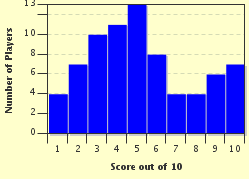Quiz Answer Key and Fun Facts
1. What is the common name for the glenohumeral joint?
2. The joint in the bony pelvis formed by the sacrum is linked to which other part of the pelvis?
3. Which of the following joints is found in the neck?
4. How many interphalangeal joints are there in the thumb?
5. There are fibrous joints between the bones of the skull. What are these joints termed as?
6. The joint between the jaw and the head is abbreviated as TMJ. What is the full form?
7. The acromioclavicular joint is between the clavicle and a part of which other bone?
8. Which of the following bones is not involved in forming the ankle joint?
9. Which of the following articulations are not involved in making the elbow joint?
10. In the knee joint, there is articulation between the tibia and the patella.
Source: Author
Saleo
This quiz was reviewed by FunTrivia editor
rossian before going online.
Any errors found in FunTrivia content are routinely corrected through our feedback system.


